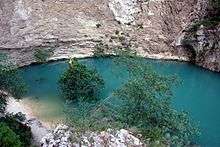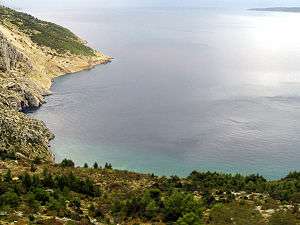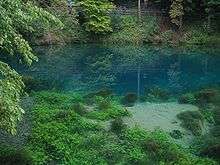Karst spring



A karst spring[1] is a spring that is part of a karst system. That includes the underground drainage of a much larger area, which means that karst springs often have a very large discharge. Because of their often conical or bowl shape, such water sources are also known in German-speaking lands as a Topf ("pot") which is reflected in names such as Aachtopf (the source of the Radolfzeller Aach) or Blautopf (the source of the Blau river in Blaubeuren).
Karst springs are usually the end of a cave system at the place where a river cave reaches the Earth's surface. Thus, it is often possible to enter the caves at a karst spring and explore them. Large karst springs are located in many parts of the world. The world's largest karst springs are believed to be in Papua New Guinea, with others located in Mediterranean countries including Bosnia, Turkey, Slovenia and Italy.[2]
Types
An estavelle or inversac is a ground orifice which, depending on weather conditions and season, can serve either as a sink or as a source of fresh water. It is a type of sinkhole.[3]
A Vauclusian spring is a spring that originates from a shaft or a cave system, with the water surging upwards under relatively high pressure. It is named after the Fontaine de Vaucluse in southern France.[3]
Submarine karst springs, also known as vruljas, occur worldwide, and are most numerous in shallow waters of the Mediterranean Sea.[3]
Hydrological features
The main feature of karst springs results from the fact that water is rapidly transported by underground caverns. This means that there is minimal filtering of the water and little separation of different sediments. Groundwater emerges at the spring within a few days. Storms, snowmelt, and general seasonal changes in rainfall have a very noticeable and rapid effect on karst springs.
Many karst springs dry up during the driest part of the year and are thus known as intermittent springs. Still others are dry most of the year round and only flow after heavy rain. Sources that only flow during wet years are often known in German as Hungerbrunnen ("hunger springs"), the reason being that folklore sees a connection between the flow rate of a spring and poor yield in a wet year. It is however more of a culturally related superstition. Scientific studies on various Hungerbrunnen have not confirmed such a relationship. An example is the Hungerbrunnen in the parish of Heuchlingen near Gerstetten.
The properties of karst springs make them unsuitable for the supply of drinking water. Their uneven flow rate does not support steady rates of consumption, especially in summer when there is lower discharge but higher demand. In addition, poor filtering and high hardness mean that the water quality is poor. For these reasons, karst springs are nowadays rarely used for drinking water.
Cultural references
The French Realist painter Gustave Courbet (1819-1877) painted a number of karst springs among many landscapes he depicted in the Jura region of eastern France.[4]
See also
References
- ↑ Whittow, John (1984). Dictionary of Physical Geography. London: Penguin, 1984, p. 291. ISBN 0-14-051094-X.
- ↑ Ford, Derek; Williams, Paul D. (2013). Karst Hydrogeology and Geomorphology. John Wiley & Sons.
- 1 2 3 Elmer LaMoreaux, Philip (2001). "Geologic/Hydrogeologic Setting and Classification of Springs". Springs and Bottled Waters of the World: Ancient History, Source, Occurrence, Quality and Use. Springer. p. 57. ISBN 978-3-540-61841-6.
- ↑ Fumey, G. (2007). "Courbet, peintre du calcaire". Karstologia. 50: 49–51. Retrieved 2016-11-08.
External links
| Wikimedia Commons has media related to Karst springs. |
- Karst springs in Germany (in German)
- The Hungerbrunnen in the Leinleiter valley (in German)

